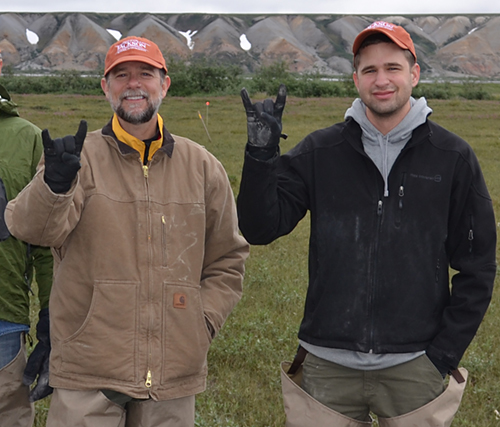Abolt, Almansour Receive Awards for Earth Science Research
Two Bureau postgraduate students recently received prestigious awards for research in their fields of hydrology and fracture studies.

Advisor Michael Young (left) and award winner Chuck Abolt on the tundra in Alaska
PhD student Chuck Abolt was recently awarded a NASA Earth and Space Science Fellowship for his work on arctic soils titled “Feedbacks between topography and three-dimensional fluxes of heat, water, and carbon in ice wedge polygons.” Abolt is one of just 69 awardees chosen from 385 applicants in the Earth science field; his award was based on scientific merit, relevance to NASA’s objectives in Earth and space science, and academic excellence. Working with PhD advisor and Bureau associate director Michael Young as principal investigator (PI), Abolt will explore two hypotheses regarding changing topography and the interrelationships between heat, water, and soil carbon levels of ice-wedge polygons to better understand the geomorphology of the Alaskan tundra. The study will employ an advanced 3D computer model of thermal hydrology, with simulations calibrated against continuing subsurface temperature observations at six depths and resulting concepts to be extrapolated to a second site. The study also includes development of a software application to survey a study area of more than 480 sq km of tundra to estimate rates of groundwater release at a landscape scale. The study will employ data from the Fourier Transform Spectrometer flown on NASA’s CARVE mission and the OCO-2 satellite to determine whether differences in carbon emissions from different ice-polygon types can be detected using airborne and spaceborne sensors. The 2-year study will begin in September, with completion scheduled for August 2019. Abolt received his MS in geological sciences in 2015 from the Jackson School of Geosciences at The University of Texas at Austin. His thesis was “Simulation of ice wedge polygon geomorphic transition, Prudhoe Bay, Alaska.”

Director's Award Winner Abdulaziz Almansour
Abdulaziz Almansour is the recipient of the 2017 Director’s Award from the Energy and Earth Resources (EER) Graduate Program in recognition of his insightful research and an outstanding presentation of his work at the recent Jackson School Master’s Saturday Symposium. The recognition is accompanied by a substantial cash prize, which Almansour shares with fellow EER student and co-awardee Ben Griffiths. Almansour was also a finalist among Jackson School students for an award for the best-written abstract. Almansour’s research, “Multidisciplinary technology and economic impact study of fracture prediction methods,” applies geologic, engineering, and economic analysis to evaluate the technical effectiveness and economic value of a fracture-characterization method that uses limited subsurface information to diagnose the presence or absence of open fractures. Software that Almansour developed as part of the study allows decision makers to calculate the value of information using play-specific geologic and cost parameters to evaluate any type of technology or test. One outcome of the research on the fracture-diagnostic method is a tangible demonstration of the high economic value of new, fundamental insights into natural fracture processes developed in the SDI program. A manuscript describing Almansour’s study will be available before the end of the summer. Almansour’s research supervisors are the Bureau’s Stephen E. Laubach, PI of the Fracture Research and Application Consortium, and Eric Bickle, professor of Operations Research and Industrial Engineering at UT Austin.